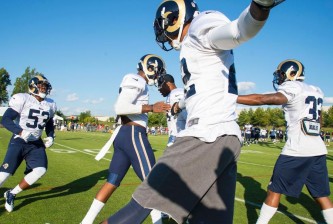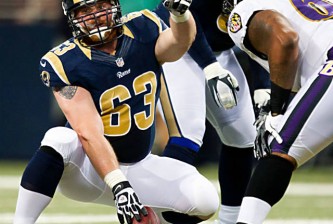 Bryan Kehl: From the Giants’ waivers to Rams starter at WLB.
Bryan Kehl: From the Giants’ waivers to Rams starter at WLB.Many Rams draft boards are going to put weakside linebacker high on their list of priorities. How bad is this need? Let’s put on our research caps and find out.
Firstly, by definition the “weak side” linebacker lines up on defense alongside Laurinaitis, facing the side of the offensive line that is unprotected by a tight end. The linebacker that lines up opposite the TE is called the “strong side” LB. However, this assumes an offense is lining up in a 1-TE formation; if the offense lines up four wide, the defense will want to sub these guys off the field and bring in additional cover DBs.
Before we debate the needs of the Rams at linebacker, particularly on the weakside, it’s important to understand how the Rams populated that position in 2010. Thanks to the stats at ProFootballFocus, we can do just that. Full analysis (and some helpful infographics) after the break:
Here is a quick chart showing the snap counts for the four players to play the position — and how many times per game the Rams simply went without, in nickel or dime defenses.
As is obvious from the chart, the most telling story at weakside linebacker was the steady decline of starter Larry Grant. Grant was one of the overachieving success stories to come out of training camp, but has never been a full time starter in the NFL, and either wore down or wore out the patience of his coaches, or both as the season went on. By the end of the season, a rotation of Bryan Kehl and Chris Chamberlain — two special teamers trying to make it on guts alone — had taken all of the available snaps at the position.
Of the three primary weakside LBs, PFF observers liked Kehl’s work the best: he rated 30th of 109 qualifiers on the outside. Not bad for a special teams player snagged off the Giants’ waiver wires in September, and a fine example of Spagnuolo’s ability to put together a productive unit from spare parts. Chamberlain rated 77th and was essentially ‘neutral,’ neither good nor terrible; Grant rated 106th on their list, deep in the red.
If we compare this usage chart to the Rams’ strongside linebackers, another trend emerges:

A healthy Na’il Diggs was able to hold down the position for most of the season, with David Vobora able to step in handily over the past three, and PFF rated both positively. But the strongside position plays considerably fewer snaps (603 of a possible 1090) compared to the weakside spot (733 of a possible 1090). This reflects Spags’ heavy usage of a three-safety look, with Craig Dahl or James Butler coming off the bench, as well as dime-package defenses with additional cover DBs.
Opposing offenses rarely targeted the strongside LB position through the air; Diggs and Vobora were thrown on only 21 times, allowing 15 completed passes. (By definition, the strong side is the side of the defense opposite the tight end on offense; that doesn’t necessarily mean that Diggs and Vobora would always be covering TEs, but that would be their primary responsibility.)
However, opposing offenses lit up the Rams’ weakside spot, sending backs and slot men through the zone with regularity. Grant (11 of 14), Kehl (10 of 12), Chamberlain (9 of 10) combined to allow 30 completions of 36 passes their way, a shockingly high number. Considering that the WLB is much more likely to be on the field on first and second downs, this weakness gave opposing offenses an easy way out of third-and-long situations, neutering the pass rush.
Can the Rams improve the position from within?
With Grant getting more exposed as the season went on, his future with the team looks cloudy. But even if a rotation involving Kehl and Chamberlain continued to overachieve at the position, neither has the coverage chops or natural speed to rate a significant improvement in the passing game. If the Rams are going to improve on the weakside, it will have to come via an influx of talent.
The question for Spagnuolo and Flajole is: how keenly do they feel this pain? Spags’ defenses in New York never had blue-chip talent at outside linebacker, and he may be happy to go with blue-collar guys, and upgrade other pressing areas in the secondary and on the D-line. In the defensive chess match, he may even be willing to concede soft completions for short yardage at the position, as long as he has enough men in blue to make the tackle and prevent long gains. Clearly, in the decision to cut coverage-minded Bobby Carpenter, Spags prefers tacklers at the position over coverage and finesse.
Bottom line: this may be a position where our perceived need is greater than the coaches’.























